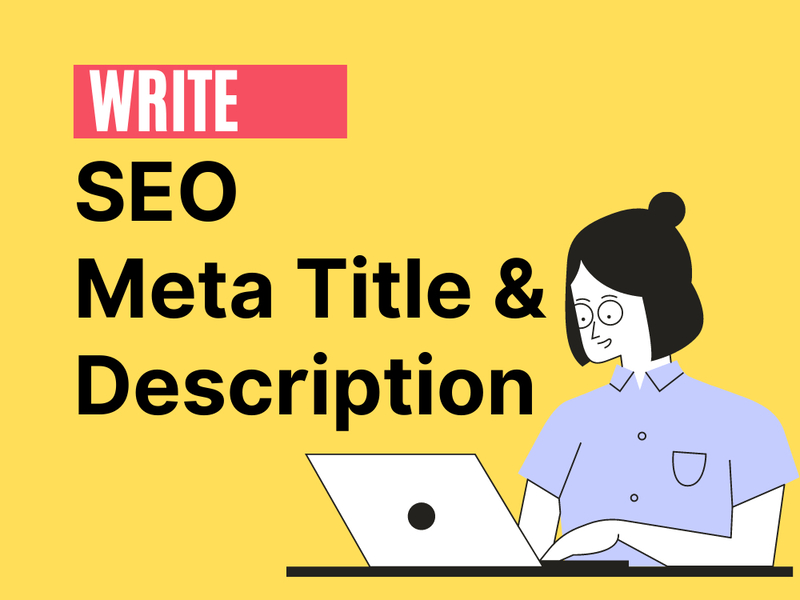
Meta title and meta description are two important page elements that help both search engines and internet users understand what your webpage is about. For beginners learning the basics of SEO, it’s crucial to grasp what these elements are, why they matter, how they appear in Google search results, and how to write them properly.
What is a Meta Title?
A meta title (also known as a page title or title tag) is a short phrase that describes the page’s content. Technically, the meta title is the <title> tag in the HTML document’s <head> section. Search engines read this title, and it is displayed at the top of your browser window or browser tab. Typically, a meta title is a brief sentence of a few words that clearly indicates the topic of the page.
What is a Meta Description?
A meta description is an HTML meta tag that provides a short summary of the page’s content. The meta description is not visible on the webpage itself; search engines read it, and users usually see it as the page summary in search result pages, shown below the meta title. Generally, it’s a short paragraph (a couple of sentences) that succinctly describes what the page is about.
How Are the Meta Title and description displayed in Google Search Results?
For example, in Google search results, the clickable blue headline at the top of a result is the page’s meta title, and the short gray text underneath it is the meta description summarizing the page’s content. Together, these two elements form the search result snippet, which helps users decide which result to click.
On search engine results pages (SERPs), the meta title appears as the main clickable title (usually in blue), and the meta description is shown below it in a smaller gray font. You can also see the meta title when you open the page – it will appear on the browser tab or window title. Moreover, if you share a page link on social networks, often the meta title and description are automatically used to generate the link preview. Thus, these elements are important not only for SEO and search visibility but also for the user experience across various platforms.
Why are Meta Title and Meta Description important for SEO?
Meta titles and meta descriptions play a significant role in both SEO and user experience. The meta title is the first piece of information a user sees among the search results. A clear and compelling page title helps the user quickly understand what to expect on the page and can encourage them to click the link. For search engines, the meta title also provides signals about the page’s topic – in fact, a well-crafted meta title with targeted keywords is considered one of the on-page ranking factors. This means an optimized meta title can contribute to higher rankings in search results.
The meta description, while not a direct ranking factor (Google officially does not use it for ranking pages), is very important for improving click-through rate (CTR). A good, relevant meta description can increase the likelihood that users will choose your link because the description lets them know your page likely contains what they’re looking for. The more people click your result, the more traffic you get – and this indirectly can help your rankings, since Google does observe user behavior signals like engagement. Furthermore, meta descriptions help shape the user’s impression of the page before they even visit: an informative, well-written description creates a sense of professionalism and trustworthiness for your site.
Recommended character counts
Both meta titles and meta descriptions have length guidelines (often measured in characters or pixel width) to ensure they display fully in search results without getting cut off.
- Meta Title Length: It’s recommended to keep meta titles around 50–60 characters long (including spaces).
This length generally allows the entire title to show in Google’s results. If your title is longer, Google might truncate it and add an ellipsis (“…”) at the end, meaning users won’t see the full title.
- Meta Description Length: The recommended length for meta descriptions is about 150–160 characters (including spaces).
In practice, around 155 characters is often suggested as a comfortable limit. This typically fits into two lines on Google’s search results. If the description is longer, the search engine may cut it off. On the other hand, if it’s too short (less than roughly 50–70 characters), it might not provide enough information, and Google might decide to show a different snippet of text from your page instead. Aim for a meta description long enough to be descriptive (at least 70-100 characters) but no more than about 155-160 characters.
Note: Character count isn’t an absolute rule – different characters vary in width (for example, “W” takes more space than “I”). Google actually measures the limits in pixels (approximately 600 px width for titles and ~920 px for descriptions). However, if you stick to the recommended character ranges above, you can be confident your meta title and description will display without being cut off in most cases.
How to write a good Meta Title: practical tips
When crafting meta titles, remember they should be informative and appealing to both search engines and users. Here are some practical tips to help you create high-quality meta titles:
- Clearly describe the page content. The user should immediately understand what the page is about from the title. Avoid ambiguous or overly generic phrasing. Be specific and relevant to the page’s content.
- Include the most important keyword. Ideally, the page’s main keyword (or key phrase) appears in the meta title, preferably toward the beginning. This helps search engines associate the page with the term, and it catches users’ eyes because the query terms will be bolded in the results. Of course, make sure it reads naturally – don’t sacrifice readability just to push a keyword to the front.
- Keep it within the optimal length (~50–60 characters). This ensures the entire title will be visible in search results. If the title is too long, important information might get cut off, reducing its impact.
- Make each page title unique. Avoid duplicating meta titles across different pages of your site. Each page deserves its own distinct title that reflects its content. Duplicate titles can confuse users (and search engines), and they might make search engines suspect your pages have repetitive content.
- Consider adding your brand name (when appropriate). It’s often recommended to include your website or brand name at the end of the meta title, separated by a delimiter like a pipe | or dash. This can help build brand recognition and trust. For example, a blog post title might end with “… | YourCompanyName”. However, if your titles are running long or if your brand isn’t well-known, you can omit it – never sacrifice a clear description of the page just to include the brand.
- Make it enticing – include a call-to-action or unique value if suitable. If space allows, you can add a little extra to make the title more compelling. This could be a call-to-action (CTA) or a highlight of something unique on the page. For instance, phrases like “free shipping”, “50% off”, “try it now” can attract attention – this is particularly useful for e-commerce pages. Ensure that any such addition matches the page content and provides a real incentive for the user to click.
- Avoid keyword stuffing and gimmicks. Do not cram your title with too many keywords or repeat the same words over and over – that looks spammy and unprofessional, and it might actually hurt your rankings. Also, avoid Writing In ALL CAPS or using excessive punctuation!!! – text in all caps is harder to read and can come across as shouting. Stick to one or two primary keywords, and focus on making the title appealing and natural for readers.
Example meta title: “Men’s sneakers – new collection | ManoBatai.lt” (51 characters)
This title clearly indicates that the page offers a new collection of men’s sneakers. The main keyword “men’s sneakers” is right at the beginning, and the site’s brand name is included at the end. The total length is 51 characters, which is safely under ~60, so the entire title will be visible in Google’s results.
How to write a good Meta Description: practical tips
The meta description’s job is to present the page content in a concise, attractive way – almost like an advertisement for the page – so that users are intrigued enough to click. Keep these tips in mind when writing meta descriptions:
- Briefly summarize the page content. In a couple of sentences, explain what the user will find on the page or what benefit they’ll get. The meta description should capture the essence of the page. A reader should be able to tell at a glance if the page matches what they’re looking for.
- Engage the reader (think like copywriting). A good meta description acts like a small ad for your page. The text should be specific, informative, and attention-grabbing. Use inviting language, and consider posing a question or promising a clear benefit to spark interest. For example, phrases like “Find out how…,” “Discover…,” “Learn the secrets…,” or “Experience…” can pique curiosity. You might also highlight unique selling points or offers (e.g., “free shipping,” “24/7 customer support,” “limited-time discount”). Just make sure the tone remains appropriate and that you deliver what you promise on the actual page.
- Include important keywords. Keywords in a meta description won’t directly boost your ranking, but if the user’s search query terms appear in your description, Google will bold them in the snippet. This can draw the eye and reassure the user that your page is relevant to their search. So, naturally incorporate your main keywords or close synonyms in the description. Place the most relevant terms early if you can do so gracefully, but always prioritize a coherent, persuasive sentence over keyword placement.
- Stick to about 150 characters in length. Make sure your meta description isn’t too long – roughly 150–160 characters is a good target so it will likely fit within two lines on the results page. If it’s too lengthy, it will get cut off, and potential visitors might miss important information. Conversely, avoid descriptions that are overly short; anything under about 50–70 characters might be seen as lacking, and Google could choose to show a snippet from the page content instead. Ideally, aim for a descriptive blurb in the 100–155 character range, which is long enough to be informative but short enough to display fully.
- Give each page a unique description. Just as with titles, every page on your site should have its own distinct meta description. Do not copy one generic description across multiple pages. Duplicate descriptions can confuse searchers and search engines alike – users might see the same summary for two different pages and not understand how they differ. Take the time to write a meaningful, unique description for each important page (for example, your homepage, key product or category pages, important articles, etc.).
- Add a call-to-action when appropriate. A subtle call-to-action (CTA) in the meta description can encourage users to click. Phrases such as “Learn more,” “Sign up today,” “Get it now,” or “Browse the collection…” can create a sense of urgency or interest. You can also mention special offers or prompts like “Order today and get 20% off,” or “Free shipping on orders over $50.” These can entice the user to choose your link over others, as long as the page indeed offers what you promise.
- Ensure it matches the page content. The meta description should accurately reflect what’s on the page. Don’t mislead users with irrelevant or exaggerated claims in the description – this will not only disappoint visitors (leading them to leave quickly) but can also hurt your site’s reputation with search engines. Likewise, avoid simply stringing together a bunch of keywords without a meaningful sentence; that looks like spam and won’t inspire anyone to click.
- Avoid special characters and gimmicks. It might be tempting to use symbols like ★★★, ♥, emoji, or ALL CAPS to grab attention, but these tricks can backfire. Search engines might disregard a meta description that uses unusual characters or treat it as spammy. It’s best to stick to plain text without gimmicky characters. Keep the style professional and straightforward – let your words and content appeal to the user, rather than flashy symbols.
Example meta description: “Discover the latest men’s sneakers collection at ManoBatai.lt – a wide selection, great prices, and free shipping on orders over €50. Buy now!” (158 characters)
This meta description concisely presents the page’s content – it highlights the new collection of men’s sneakers and mentions attractive benefits (“wide selection,” “great prices,” “free shipping on orders over €50”). It also includes a call to action, “Buy now!”, encouraging the user to click through to the page. The length is about 158 characters, which should comfortably display in full on the search results page.
In summary, meta titles and meta descriptions are small elements of your webpage, but they have a big impact. They shape the first impression of your page in search results. Although these meta tags are just a few lines of text, their influence on your website’s traffic can be significant – well-written meta titles and descriptions can greatly increase your click-through rate and bring more targeted visitors to your site. Therefore, every SEO beginner (and, indeed, every webmaster) should devote time to optimizing these elements.
Keep in mind the best practices: write clearly, uniquely, and with the user in mind. Remember that each page is unique – give each one a unique voice with a well-chosen meta title and description. By doing so, you’ll help search engines better understand your content, and you’ll make it easier for users to decide that your page is the one worth clicking on.

 EN
EN  LT
LT 